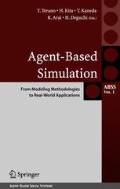Summary
A financial market example illustrates how Interactive Evolutionary Computation (IEC) can be used for agent-based model inversion. The example shows that IEC can be used to discover a model that reproduces synthetic data generated with a very simple model.
Access this chapter
Tax calculation will be finalised at checkout
Purchases are for personal use only
Preview
Unable to display preview. Download preview PDF.
References
Arthur, W. B., Holland, J. H., LeBaron, B., Palmer, R. G. & Taylor, P. (1997) Asset pricing under endogenous expectations in an artificial stock market, in The Economy as a Complex Evolving System II, eds. Arthur, W. B., Durlauf, S. & Lane, D. (Santa Fe Institute Studies in the Sciences of Complexity, Proceedings Volume XXVII, Addison-Wesley, Reading, MA).
Ball, P. (2002) Stock market shock explained. Physicists model recent trading frenzy. Nature Science Update, http://www.nature.com/nsu/020923/020923-18.html
Banzhaf, W. (1997) Interactive evoution. In: Handbook of Evolutionary Computation (T. Baeck, D. Fogel, and Z. Michalewicz, eds), Ch. C2.10, pp. 1–5, Oxford University Press.
Bonabeau, E. (2002) Agent-based modeling: methods and techniques for simulating human systems, Proc. Nat Acad. Sci. USA 99, 7280–7287
Boschetti, F., Moresi, L. 2001. Interactive inversion in geosciences. Geophysics 66, 1226–1234.
Caldarelli, G., Marsili, M. & Zhang, Y.-C. (1997) A prototype model of stock exchange. Europhys. Lett. 40, 479–484
Dawkins. R. 1987. The Blind Watchmaker. W. W. Norton, New York.
Epstein J. M., Axtell R. L. (1996) Growing artificial societies: social science from the bottom up (MIT Press, Cambridge, MA).
Farmer, J.D. (1999) Physicists attempt to scale the ivory towers of finance. Computing in Science and Engineering (IEEE), November–December 1999, 26–39.
Forrest, S. 1993. Genetic algorithms: Principles of adaptation applied to computation. Science 261: 872–878.
Goldberg, D. E. 1989. Genetic Algorithms in Search, Optimization and Machine Learning, Addison-Wesley Longman Publishing.
LeBaron, B. (2001) A builder’s guide to agent-based financial markets. Quantitative Finance 1, 254–261
Levy, M., Levy, H. and Solomon, S. (2000). Microscopic Simulation of Financial Markets: From Investor Behavior to Market Phenomena. (Academic Press, San Diego, CA).
Lux, T. & Marchesi, M. (1999). Scaling and criticality in a stochastic multi-agent model of a financial market. Nature 397, 498–500
Mantegna, R. & Stanley, H. E. (1999). An Introduction to Econophysics, Cambridge University Press
Muchnik, L. & Solomon, S. (2003). Statistical mechanics of conventional traders may lead to non-conventional market behavior. Physica Scripta T106, 41–47.
Palmer, R. G., Arthur, W. B., Holland, J. H., Le Baron, B. & Tayler, P. (1994) Artificial economic life: a simple model of a stock market, Physica D 75, 264–274.
Sims, K. 1991. Artificial evolution for computer graphics. Computer Graphics 25: 319–328.
Sims, K. 1992. Interactive evolution of dynamical systems. Pages 171–178 in: Towards a Practice of Autonomous Systems: Proceedings of the First European Conference on Artificial Life (F. J. Varela & P. Bourgine, eds.), MIT Press, Cambridge, MA.
Sims, K. 1993. Interactive evolution of equations for procedural models. Vis. Comput. 9: 446–476.
Takagi, H. 2001. Interactive evolutionary computation: fusion of the capabilities of EC optimization and human evaluation. Proc. IEEE 89: 1275–1296.
Wijns, C., Boschetti, F. & Moresi, L. 2003. Inversion in geology by interactive evolutionary computation. Journal of Structural Geology, in print.
Author information
Authors and Affiliations
Editor information
Editors and Affiliations
Rights and permissions
Copyright information
© 2005 Springer-Verlag Tokyo
About this paper
Cite this paper
Ashburn, T., Bonabeau, E., Ecemis, I. (2005). Interactive inversion of agent-based models. In: Terano, T., Kita, H., Kaneda, T., Arai, K., Deguchi, H. (eds) Agent-Based Simulation: From Modeling Methodologies to Real-World Applications. Agent-Based Social Systems, vol 1. Springer, Tokyo. https://doi.org/10.1007/4-431-26925-8_2
Download citation
DOI: https://doi.org/10.1007/4-431-26925-8_2
Publisher Name: Springer, Tokyo
Print ISBN: 978-4-431-26592-4
Online ISBN: 978-4-431-26925-0
eBook Packages: Business and EconomicsEconomics and Finance (R0)

